brake fluid RENAULT TWINGO RS 2009 2.G Chasiss Workshop Manual
[x] Cancel search | Manufacturer: RENAULT, Model Year: 2009, Model line: TWINGO RS, Model: RENAULT TWINGO RS 2009 2.GPages: 281
Page 6 of 281
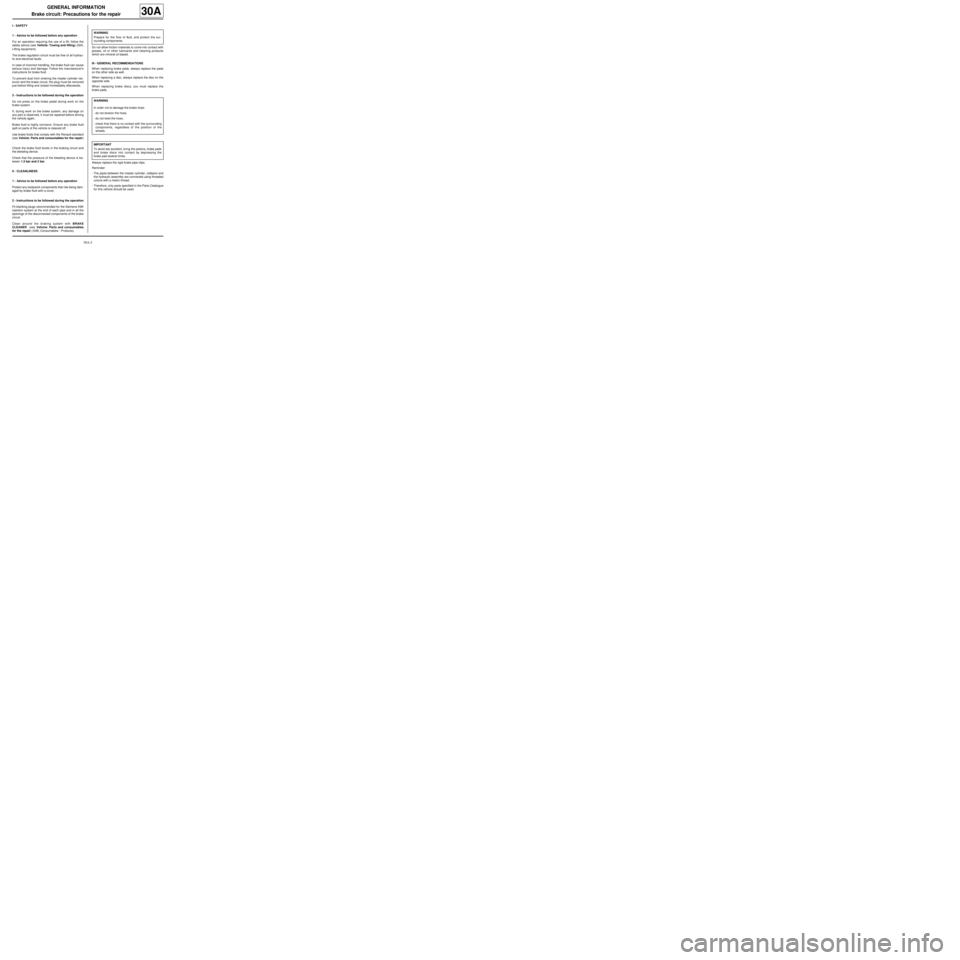
30A-2
GENERAL INFORMATION
Brake circuit: Precautions for the repair
30A
I - SAFETY
1 - Advice to be followed before any operation
For an operation requiring the use of a lift, follow the
safety advice (see Vehicle: Towing and lifting) (02A,
Lifting equipment).
The brake regulation circuit must be free of all hydrau-
lic and electrical faults.
In case of incorrect handling, the brake fluid can cause
serious injury and damage. Follow the manufacturer's
instructions for brake fluid.
To prevent dust from entering the master cylinder res-
ervoir and the brake circuit, the plug must be removed
just before filling and closed immediately afterwards,
2 - Instructions to be followed during the operation
Do not press on the brake pedal during work on the
brake system.
If, during work on the brake system, any damage on
any part is observed, it must be repaired before driving
the vehicle again.
Brake fluid is highly corrosive. Ensure any brake fluid
spilt on parts of the vehicle is cleaned off.
Use brake fluids that comply with the Renault standard
(see Vehicle: Parts and consumables for the repair)
.
Check the brake fluid levels in the braking circuit and
the bleeding device.
Check that the pressure of the bleeding device is be-
tween 1.5 bar and 2 bar.
II - CLEANLINESS
1 - Advice to be followed before any operation
Protect any bodywork components that risk being dam-
aged by brake fluid with a cover.
2 - Instructions to be followed during the operation
Fit blanking plugs recommended for the Siemens K9K
injection system at the end of each pipe and in all the
openings of the disconnected components of the brake
circuit.
Clean around the braking system with BRAKE
CLEANER (see Vehicle: Parts and consumables
for the repair) (04B, Consumables - Products).Do not allow friction materials to come into contact with
grease, oil or other lubricants and cleaning products
which are mineral oil based.
III - GENERAL RECOMMENDATIONS
When replacing brake pads, always replace the pads
on the other side as well.
When replacing a disc, always replace the disc on the
opposite side.
When replacing brake discs, you must replace the
brake pads.
Always replace the rigid brake pipe clips.
Reminder:
-The pipes between the master cylinder, callipers and
the hydraulic assembly are connected using threaded
unions with a metric thread.
-Therefore, only parts specified in the Parts Catalogue
for this vehicle should be used. WARNING
Prepare for the flow of fluid, and protect the sur-
rounding components.
WARNING
In order not to damage the brake hose:
-do not tension the hose,
-do not twist the hose,
-check that there is no contact with the surrounding
components, regardless of the position of the
wheels.
IMPORTANT
To avoid any accident, br ing the pistons, brake pads
and brake discs into contact by depressing the
brake pad several times.
Page 7 of 281
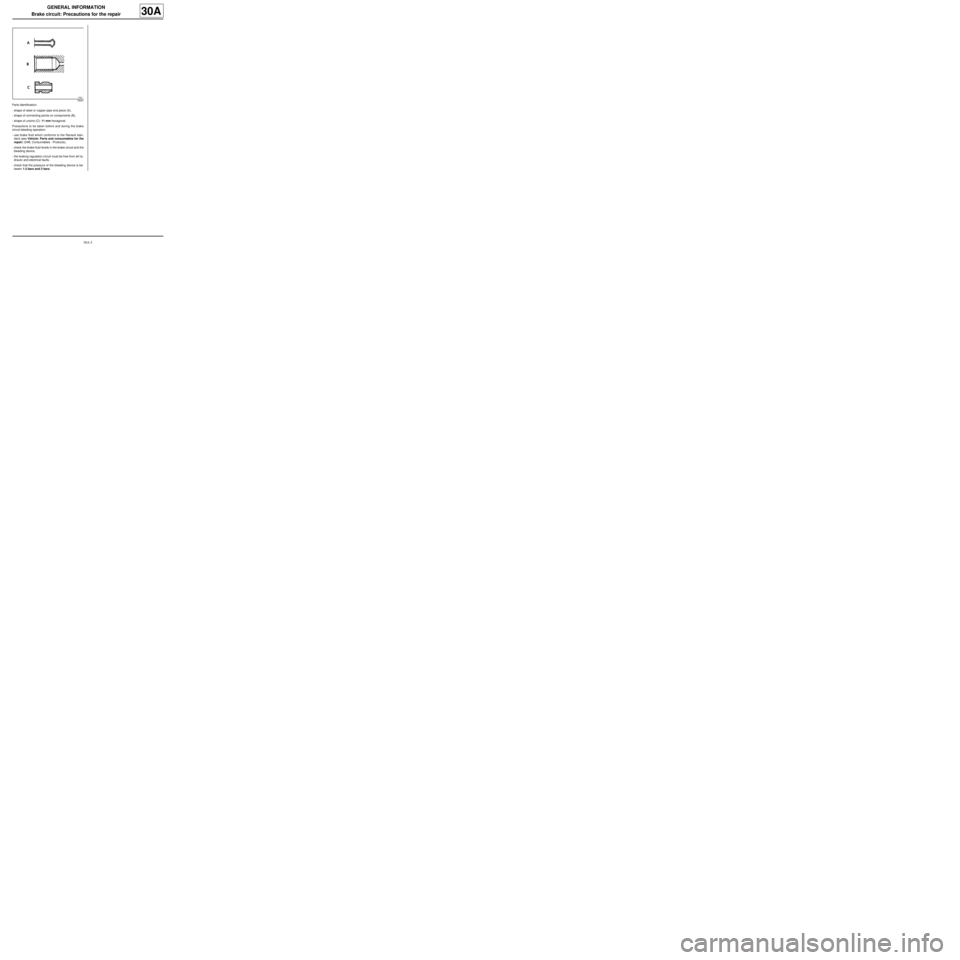
30A-3
GENERAL INFORMATION
Brake circuit: Precautions for the repair
30A
Parts identification:
-shape of steel or copper pipe end piece (A),
-shape of connecting points on components (B),
-shape of unions (C): 11 mm hexagonal.
Precautions to be taken before and during the brake
circuit bleeding operation:
-use brake fluid which conforms to the Renault stan-
dard (see Vehicle: Parts and consumables for the
repair) (04B, Consumables - Products),
-check the brake fluid levels in the brake circuit and the
bleeding device,
-the braking regulation circuit must be free from all hy-
draulic and electrical faults,
-check that the pressure of the bleeding device is be-
tween 1.5 bars and 2 bars.
78491
Page 8 of 281
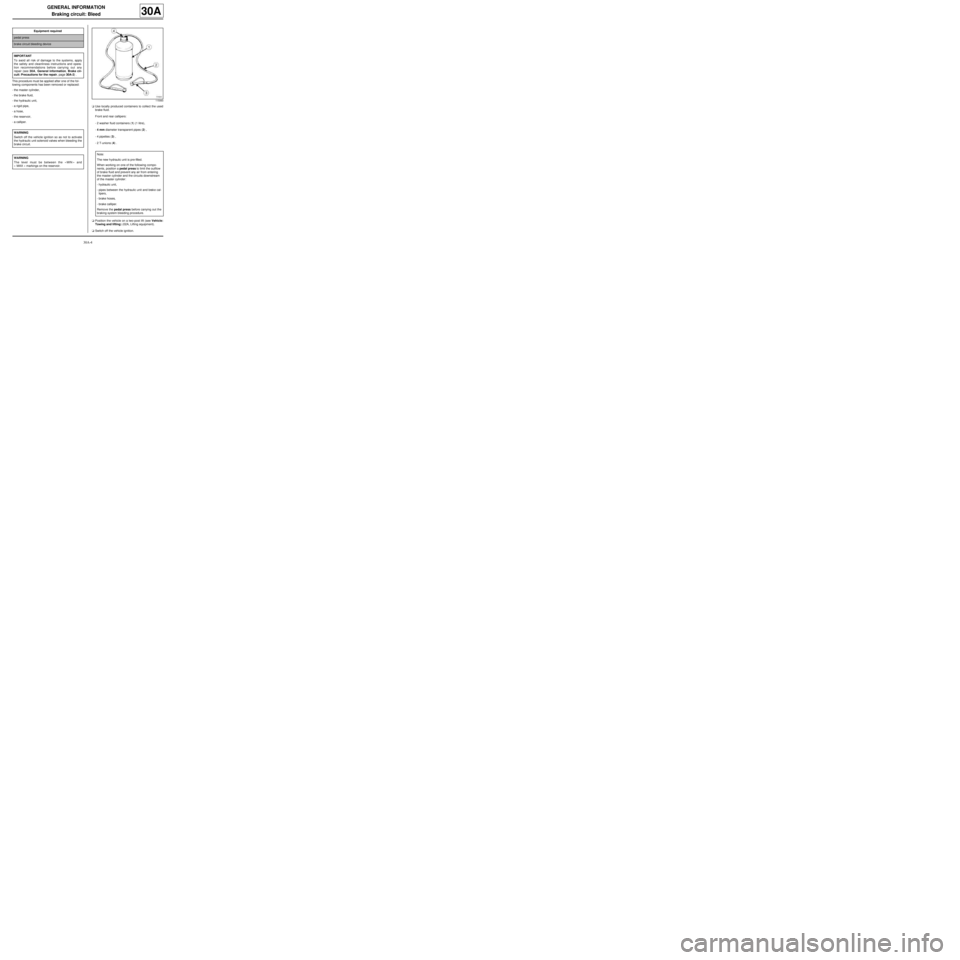
30A-4
GENERAL INFORMATION
Braking circuit: Bleed
30A
This procedure must be applied after one of the fol-
lowing components has been removed or replaced:
-the master cylinder,
-the brake fluid,
-the hydraulic unit,
-a rigid pipe,
-a hose,
-the reservoir,
-a calliper.aUse locally produced containers to collect the used
brake fluid.
Front and rear callipers:
-2 washer fluid containers (1) (1 litre),
-4 mm diameter transparent pipes (2) ,
-4 pipettes (3) ,
-2 T-unions (4) .
aPosition the vehicle on a two-post lift (see Vehicle:
Towing and lifting) (02A, Lifting equipment).
aSwitch off the vehicle ignition. Equipment required
pedal press
brake circuit bleeding device
IMPORTANT
To avoid all risk of damage to the systems, apply
the safety and cleanliness instructions and opera-
tion recommendations before carrying out any
repair (see 30A, General information, Brake cir-
cuit: Precautions for the repair, page 30A-2) .
WARNING
Switch off the vehicle ignition so as not to activate
the hydraulic unit solenoid valves when bleeding the
brake circuit.
WARNING
The level must be between the « MIN » and
« MAX » markings on the reservoir.
115993
Note:
The new hydraulic unit is pre-filled.
When working on one of the following compo-
nents , position a pedal press to limit the outflow
of brake fluid and prevent any air from entering
the master cylinder and the circuits downstream
of the master cylinder:
-hydraulic unit,
-pipes between the hydraulic unit and brake cal-
lipers,
-brake hoses,
-brake calliper.
Remove the pedal press before carrying out the
braking system bleeding procedure.
Page 9 of 281
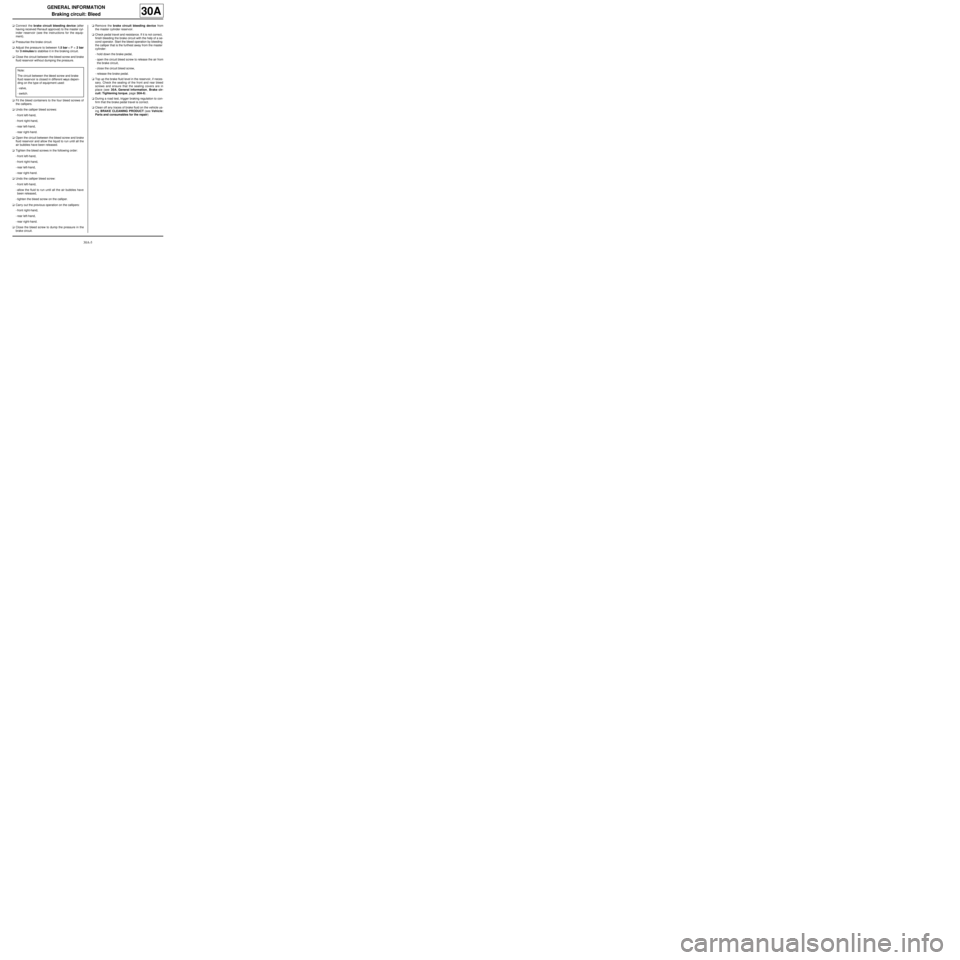
30A-5
GENERAL INFORMATION
Braking circuit: Bleed
30A
aConnect the brake circuit bleeding device (after
having received Renault approval) to the master cyl-
inder reservoir (see the instructions for the equip-
ment).
aPressurise the brake circuit.
aAdjust the pressure to between 1.5 bar < P < 2 bar
for 3 minutes to stabilise it in the braking circuit.
aClose the circuit between the bleed screw and brake
fluid reservoir without dumping the pressure.
aFit the bleed containers to the four bleed screws of
the callipers.
aUndo the calliper bleed screws:
-front left-hand,
-front right-hand,
-rear left-hand,
-rear right-hand.
aOpen the circuit between the bleed screw and brake
fluid reservoir and allow the liquid to run until all the
air bubbles have been released.
aTighten the bleed screws in the following order:
-front left-hand,
-front right-hand,
-rear left-hand,
-rear right-hand.
aUndo the calliper bleed screw:
-front left-hand,
-allow the fluid to run until all the air bubbles have
been released,
-tighten the bleed screw on the calliper.
aCarry out the previous operation on the callipers:
-front right-hand,
-rear left-hand,
-rear right-hand.
aClose the bleed screw to dump the pressure in the
brake circuit.aRemove the brake circuit bleeding device from
the master cylinder reservoir.
aCheck pedal travel and resistance. If it is not correct,
finish bleeding the brake circuit with the help of a se-
cond operator. Start the bleed operation by bleeding
the calliper that is the furthest away from the master
cylinder:
-hold down the brake pedal,
-open the circuit bleed screw to release the air from
the brake circuit,
-close the circuit bleed screw,
-release the brake pedal.
aTop up the brake fluid level in the reservoir, if neces-
sary. Check the sealing of the front and rear bleed
screws and ensure that the sealing covers are in
place (see 30A, General information, Brake cir-
cuit: Tightening torque, page 30A-6) .
aDuring a road test, trigger braking regulation to con-
firm that the brake pedal travel is correct.
aClean off any traces of brake fluid on the vehicle us-
ing BRAKE CLEANING PRODUCT (see Vehicle:
Parts and consumables for the repair) Note:
The circuit between the bleed screw and brake
fluid reservoir is closed in different ways depen-
ding on the type of equipment used:
-valve,
-switch.
Page 22 of 281
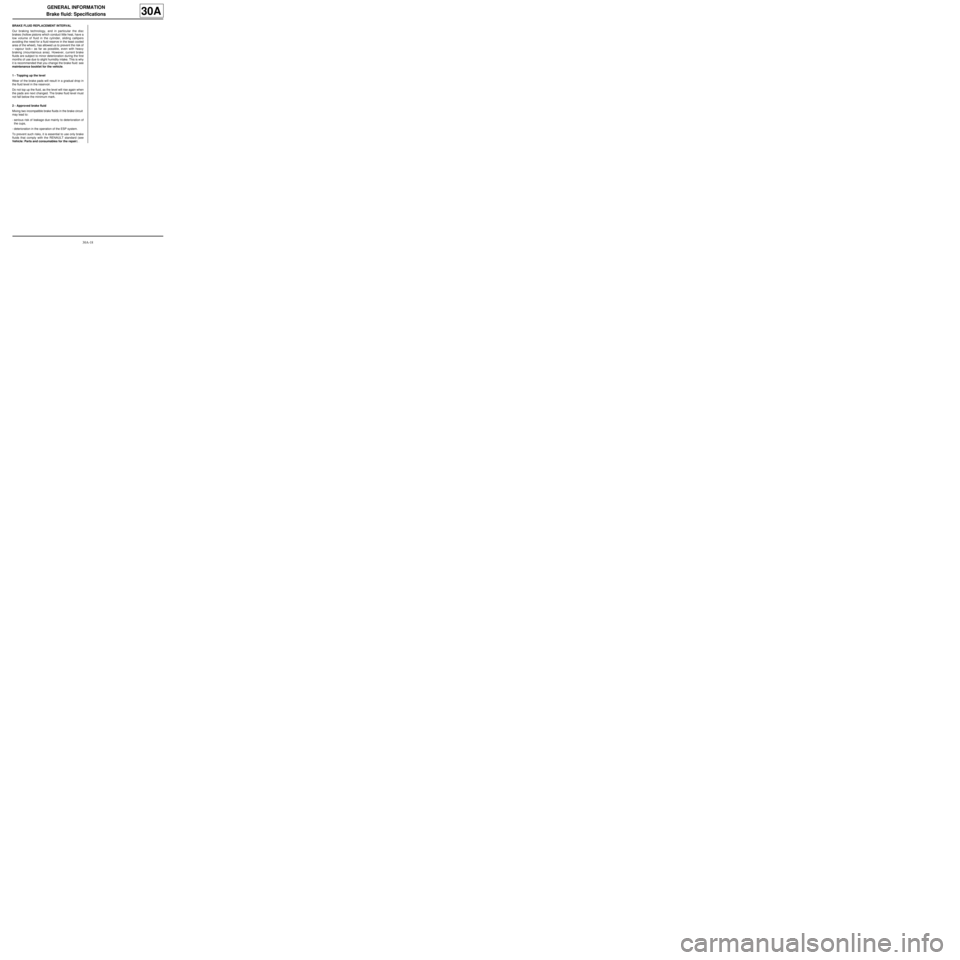
30A-18
GENERAL INFORMATION
Brake fluid: Specifications
30A
BRAKE FLUID REPLACEMENT INTERVAL
Our braking technology, and in particular the disc
brakes (hollow pistons which conduct little heat, have a
low volume of fluid in the cylinder, sliding callipers
avoiding the need for a fluid reserve in the least cooled
area of the wheel), has allowed us to prevent the risk of
« vapour lock » as far as possible, even with heavy
braking (mountainous area). However, current brake
fluids are subject to minor deterioration during the first
months of use due to slight humidity intake. This is why
it is recommended that you change the brake fluid: see
maintenance booklet for the vehicle.
1 - Topping up the level
Wear of the brake pads will result in a gradual drop in
the fluid level in the reservoir.
Do not top up the fluid, as the level will rise again when
the pads are next changed. The brake fluid level must
not fall below the minimum mark.
2 - Approved brake fluid
Mixing two incompatible brake fluids in the brake circuit
may lead to:
-serious risk of leakage due mainly to deterioration of
the cups,
-deterioration in the operation of the ESP system.
To prevent such risks, it is essential to use only brake
fluids that comply with the RENAULT standard (see
Vehicle: Parts and consumables for the repair) .
Page 49 of 281
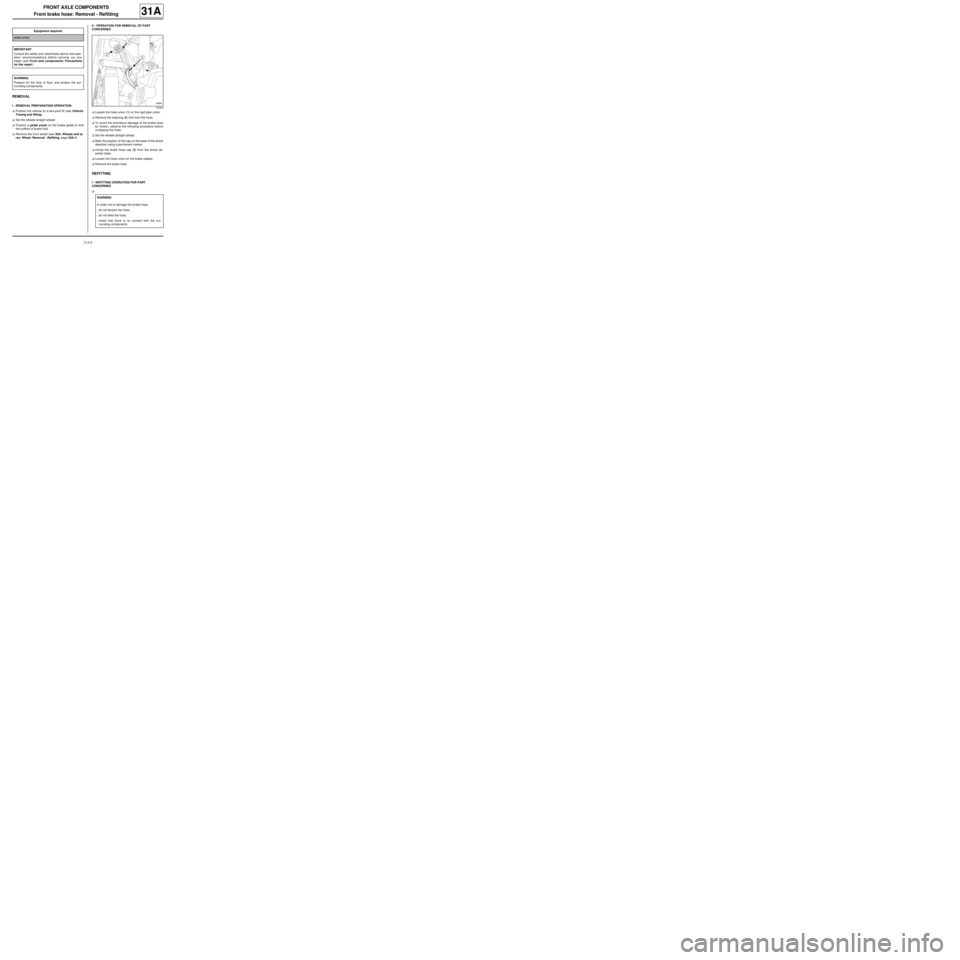
31A-6
FRONT AXLE COMPONENTS
Front brake hose: Removal - Refitting
31A
REMOVAL
I - REMOVAL PREPARATION OPERATION
aPosition the vehicle on a two-post lift (see Vehicle:
Towing and lifting) .
aSet the wheels straight ahead.
aPosition a pedal press on the brake pedal to limit
the outflow of brake fluid.
aRemove the front wheel (see 35A, Wheels and ty-
res, Wheel: Removal - Refitting, page 35A-1) .II - OPERATION FOR REMOVAL OF PART
CONCERNED
aLoosen the hose union (1) on the rigid pipe union.
aRemove the retaining (2) fork from the hose.
aTo avoid the premature damage of the brake hose
by friction, observe the following procedure before
unclipping the hose:
aSet the wheels straight ahead.
aMark the position of the cap on the base of the shock
absorber using a permanent marker.
aUnclip the brake hose cap (3) from the shock ab-
sorber base.
aLoosen the hose union on the brake calliper.
aRemove the brake hose.
REFITTING
I - REFITTING OPERATION FOR PART
CONCERNED
a Equipment required
pedal press
IMPORTANT
Consult the safety and cleanliness advice and oper-
ation recommendations before carrying out any
repair (see Front axle components: Precautions
for the repair) .
WARNING
Prepare for the flow of fluid, and protect the sur-
rounding components.
135304
WARNING
In order not to damage the brake hose:
-do not tension the hose,
-do not twist the hose,
-check that there is no contact with the sur-
rounding components.
Page 51 of 281
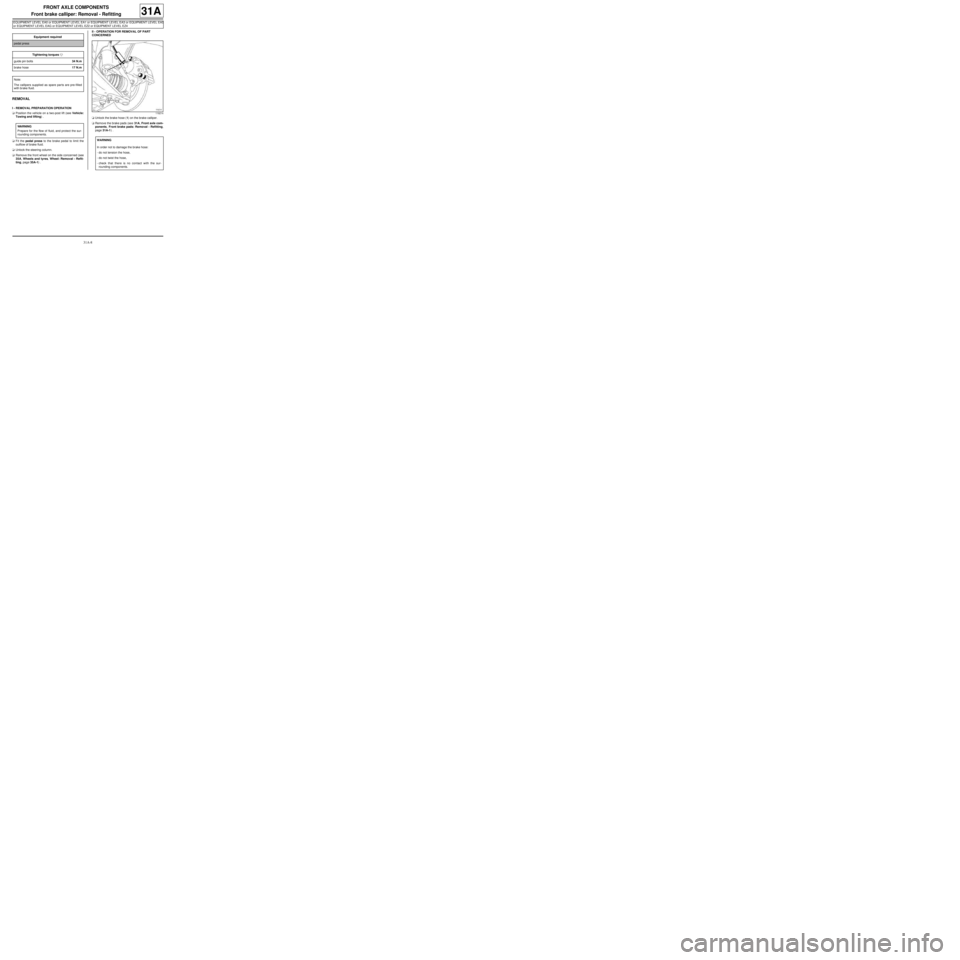
31A-8
FRONT AXLE COMPONENTS
Front brake calliper: Removal - Refitting
EQ UIPMENT LEVEL EA0 or EQUIPMENT LEVEL EA1 or EQUIPMENT LEVEL EA3 or EQUIPMENT LEVEL EA5
or EQUIPMENT LEVEL EAG or EQUIPMENT LEVEL EZ2 or EQUIPMENT LEVEL EZ4
31A
REMOVAL
I - REMOVAL PREPARATION OPERATION
aPosition the vehicle on a two-post lift (see Vehicle:
Towing and lifting) .
aFit the pedal press to the brake pedal to limit the
outflow of brake fluid.
aUnlock the steering column.
aRemove the front wheel on the side concerned (see
35A, Wheels and tyres, Wheel: Removal - Refit-
ting, page 35A-1) .II - OPERATION FOR REMOVAL OF PART
CONCERNED
aUnlock the brake hose (1) on the brake calliper.
aRemove the brake pads (see 31A, Front axle com-
ponents, Front brake pads: Removal - Refitting,
page 31A-1) . Equipment required
pedal press
Tightening torquesm
guide pin bolts34 N.m
brake hose17 N.m
Note:
The callipers supplied as spare par ts are pre-filled
with br ake fluid.
WARNING
Prepare for the flow of fluid, and protect the sur-
rounding components.
119214
WARNING
In order not to damage the brake hose:
-do not tension the hose,
-do not twist the hose,
-check that there is no contact with the sur-
rounding components.
Page 53 of 281
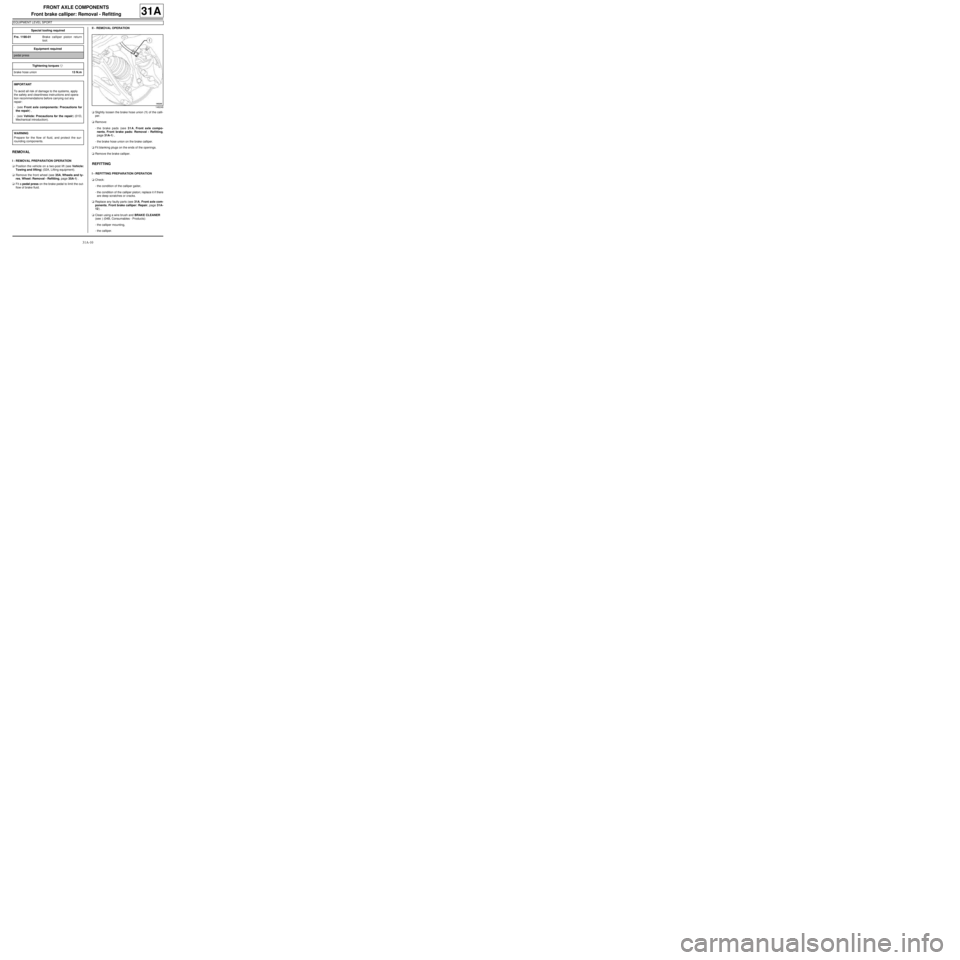
31A-10
FRONT AXLE COMPONENTS
Front brake calliper: Removal - Refitting
EQ UIPMENT LEVEL SPORT
31A
REMOVAL
I - REMOVAL PREPARATION OPERATION
aPosition the vehicle on a two-post lift (see Vehicle:
Towing and lifting) (02A, Lifting equipment).
aRemove the front wheel (see 35A, Wheels and ty-
res, Wheel: Removal - Refitting, page 35A-1) .
aFit a pedal press on the brake pedal to limit the out-
flow of brake fluid.II - REMOVAL OPERATION
aSlightly loosen the brake hose union (1) of the calli-
per.
aRemove:
-the brake pads (see 31A, Front axle compo-
nents, Front brake pads: Removal - Refitting,
page 31A-1) ,
-the brake hose union on the brake calliper.
aFit blanking plugs on the ends of the openings.
aRemove the brake calliper.
REFITTING
I - REFITTING PREPARATION OPERATION
aCheck:
-the condition of the calliper gaiter,
-the condition of the calliper piston; replace it if there
are deep scratches or cracks.
aReplace any faulty parts (see 31A, Front axle com-
ponents, Front brake calliper: Repair, page 31A-
12) .
aClean using a wire brush and BRAKE CLEANER
(see ) (04B, Consumables - Products):
-the calliper mounting,
-the calliper. Special tooling required
Fre. 1190-01Brake calliper piston return
tool.
Equipment required
pedal press
Tightening torquesm
brake hose union13 N.m
IMPORTANT
To avoid all risk of damage to the systems, apply
the safety and cleanliness instructions and opera-
tion recommendations before carrying out any
repair:
- (see Front axle components: Precautions for
the repair) ,
- (see Vehicle: Precautions for the repair) (01D,
Mechanical introduction).
WARNING
Prepare for the flow of fluid, and protect the sur-
rounding components.
146248
Page 55 of 281
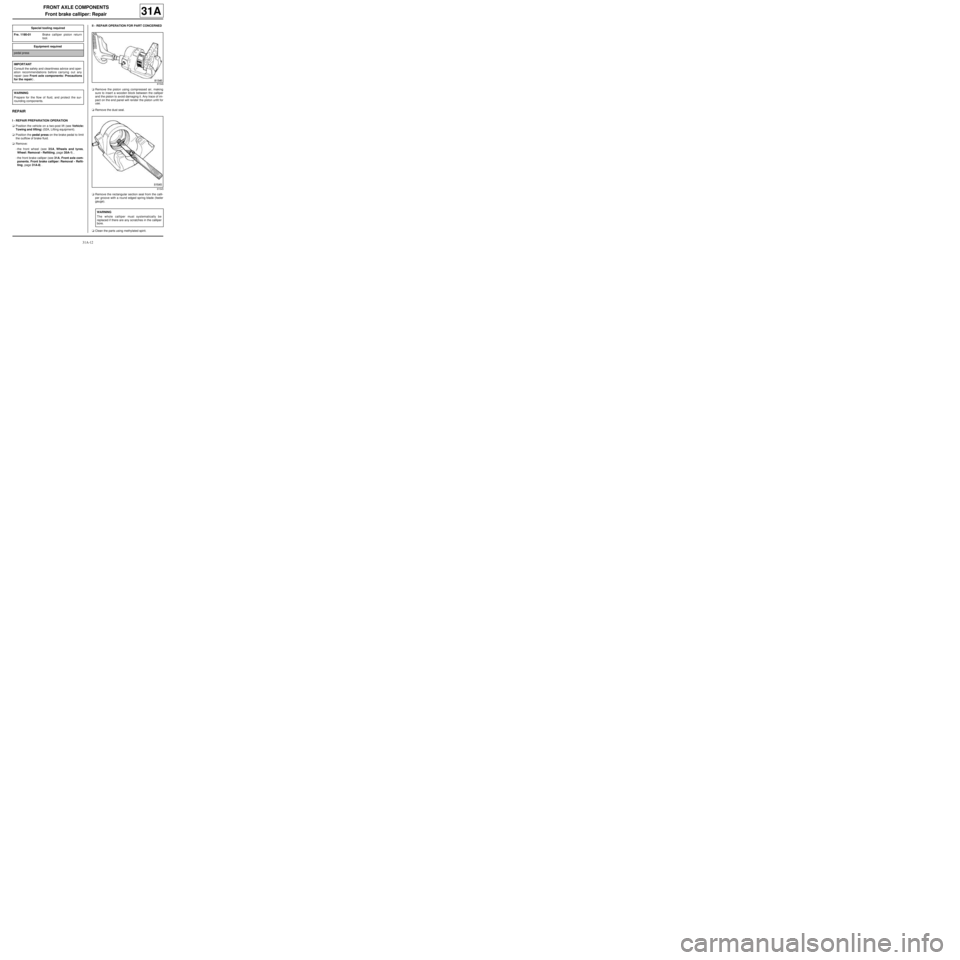
31A-12
FRONT AXLE COMPONENTS
Front brake calliper: Repair
31A
REPAIR
I - REPAIR PREPARATION OPERATION
aPosition the vehicle on a two-post lift (see Vehicle:
Towing and lifting) (02A, Lifting equipment).
aPosition the pedal press on the brake pedal to limit
the outflow of brake fluid.
aRemove:
-the front wheel (see 35A, Wheels and tyres,
Wheel: Removal - Refitting, page 35A-1) ,
-the front brake calliper (see 31A, Front axle com-
ponents, Front brake calliper: Removal - Refit-
ting, page 31A-8) .II - REPAIR OPERATION FOR PART CONCERNED
aRemove the piston using compressed air, making
sure to insert a wooden block between the calliper
and the piston to avoid damaging it. Any trace of im-
pact on the end panel will render the piston unfit for
use.
aRemove the dust seal.
aRemove the rectangular section seal from the calli-
per groove with a round edged spring blade (feeler
gauge).
aClean the parts using methylated spirit. Special tooling required
Fre. 1190-01Brake calliper piston return
tool.
Equipment required
pedal press
IMPORTANT
Consult the safety and cleanliness advice and oper-
ation recommendations before carrying out any
repair (see Front axle components: Precautions
for the repair) .
WARNING
Prepare for the flow of fluid, and protect the sur-
rounding components.
81546
81545
WARNING
The whole calliper must systematically be
replaced if there are any scratches in the calliper
bore.
Page 102 of 281
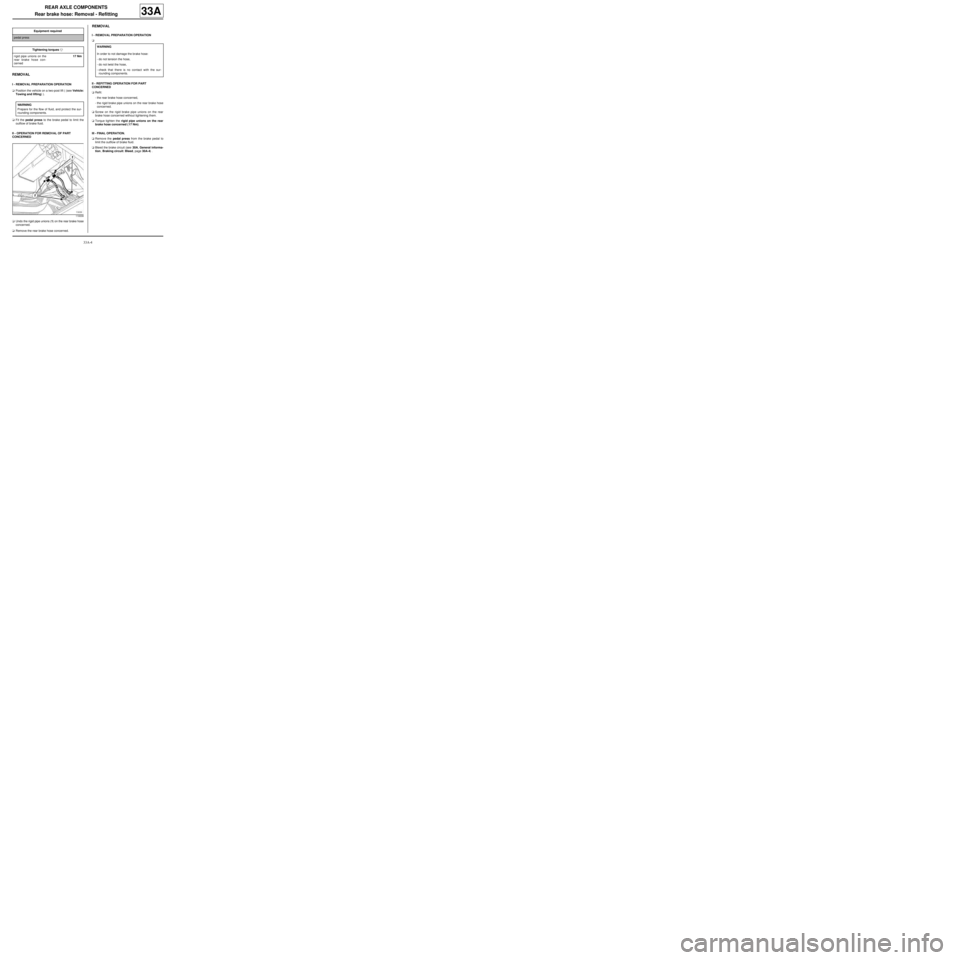
33A-4
REAR AXLE COMPONENTS
Rear brake hose: Removal - Refitting
33A
REMOVAL
I - REMOVAL PREPARATION OPERATION
aPosition the vehicle on a two-post lift ( (see Vehicle:
Towing and lifting) ).
aFit the pedal press to the brake pedal to limit the
outflow of brake fluid.
II - OPERATION FOR REMOVAL OF PART
CONCERNED
aUndo the rigid pipe unions (1) on the rear brake hose
concerned.
aRemove the rear brake hose concerned.
REMOVAL
I - REMOVAL PREPARATION OPERATION
a
II - REFITTING OPERATION FOR PART
CONCERNED
aRefit:
-the rear brake hose concerned,
-the rigid brake pipe unions on the rear brake hose
concerned.
aScrew on the rigid brake pipe unions on the rear
brake hose concerned without tightening them.
aTorque tighten the rigid pipe unions on the rear
brake hose concerned ( 17 Nm).
III - FINAL OPERATION.
aRemove the pedal press from the brake pedal to
limit the outflow of brake fluid.
aBleed the brake circuit (see 30A, General informa-
tion, Braking circuit: Bleed, page 30A-4) . Equipment requiredpedal press
Tightening torquesm
rigid pipe unions on the
rear brake hose con-
cerned17 Nm
WARNING
Prepare for the flow of fluid, and protect the sur-
rounding components.
119339
WARNING
In order to not damage the brake hose:
-do not tension the hose,
-do not twist the hose,
-check that there is no contact with the sur-
rounding components.